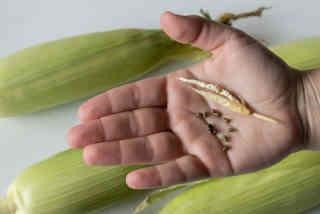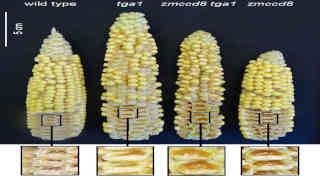
“Teosinte, the wild ancestor of corn, is unrecognizable to us as corn today,” said Karen Koch, senior author of the study and a professor in the UF/IFAS horticultural sciences department.
Teosinte is a small, grass-like plant that forms ears of six to eight kernels. Each kernel is encased in an acorn-like shell. These encased kernels grow on a thin stem, not the thick cob that characterizes modern corn. The whole ear is about two inches long, the kernels no larger than peppercorns.
About 10,000 years ago, the Indigenous peoples of what is now southern Mexico began selectively breeding teosinte. Over time, those acorn-like coverings retracted and formed a cob. Now exposed, the kernels were easier to harvest and could be bred for increased number and size, Koch said.
“Those of us who study corn are always fascinated by how its ear went from this tiny, spindly thing to developing a cob with hundreds of large kernels. This transformation is what allowed corn to be one of the most productive cereal crops in the world,” Koch said, noting that most corn researchers call the plant “maize.” Both field corn and sweet corn are maize.
Koch and the study’s first author, Jiahn-Chou Guan, both study the physiology of modern maize, and never imagined their research into strigolactones would help illuminate its distant past.
“It was initially a surprise to us. As part of an earlier study on strigolactones, we began working with a type of maize that didn’t make strigolactones. We noticed it had a striking combination of primitive features that resembled ancient maize, so we investigated further,” Koch said.
In the world of corn domestication research, only one gene, Teosinte glume architecture 1, or Tga1, had been identified as partially influencing those primitive features. But now the scientists hypothesized that strigolactones also had an important function.
That hypothesis spurred the current study. Guan bred corn plants with specific genetic mutations that allowed him to test the effect of strigolactones in the developing ears. Some plants had mutations that prevented them from making strigolactones or that made their cells unresponsive to the hormone. Some of these plants also had either the ancestral or domesticated form of the Tga1 gene.
The whole process of producing plants with the right combination of traits took seven years, Guan said. But the investment paid off.

The plants bred for the study produced corn kernels surrounded by partial shells formed by the same protective, acorn-like structures of ancient corn. This extra tissue partially protected kernels, but also constrained their growth, so much that many were choked or even killed if they expanded to modern day size.
When Guan first saw these features, he was shocked. It was as if the corn had regressed to an earlier form.
“Those were ‘ah ha moments’ to me! It feels like discovering a hidden secret that no one has ever imagined before,” said Guan, a research associate professor in the horticultural sciences department.
Still, there is much to be learned about how strigolactones orchestrate the development of modern corn ears, Guan said.
“The increase in kernel and ear size requires a lot of input from the source organs like leaves and roots,” Guan said. “Understanding the extent to which strigolactones coordinate the resource remobilization may answer questions about how this important physiological process was engineered during the conversion of the grassy-like teosinte to modern maize.”
A better understanding of strigolactones in corn may also have implications for growing it in Sub-Saharan Africa, where a parasitic plant called witchweed makes growing corn almost impossible, Koch said.
“Witchweed is attracted to strigolactones in roots of the maize plant. It taps into these roots and sucks away the water and resources like its vampire-witch name implies. However, if we could develop maize that doesn’t produce this hormone in its roots, that could be a breakthrough for growing maize in the region,” Koch said.
Source : ufl.edu